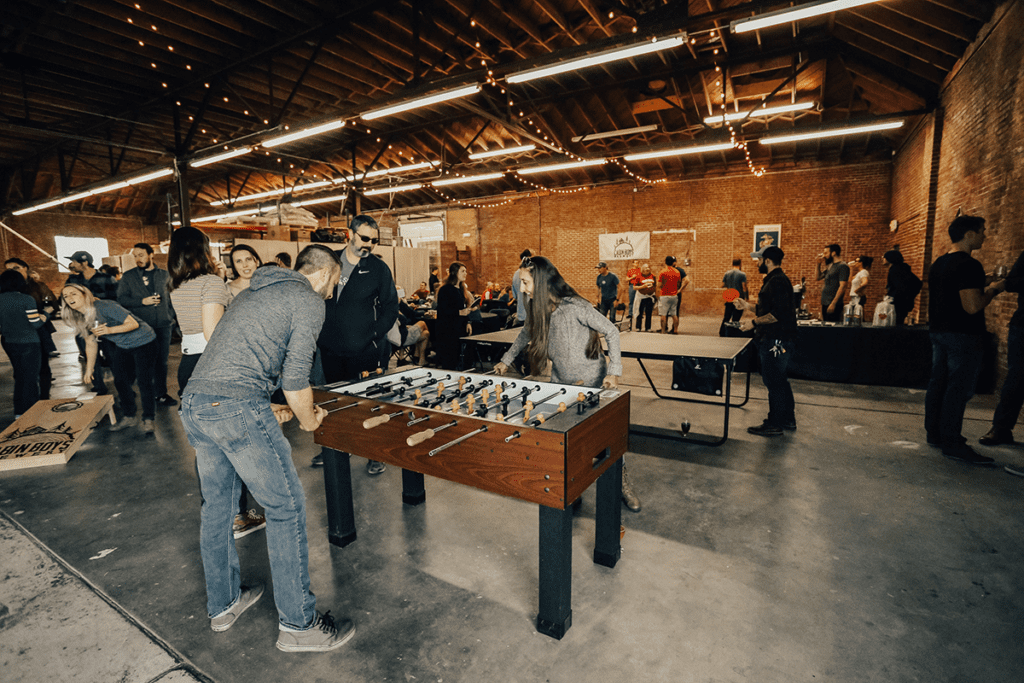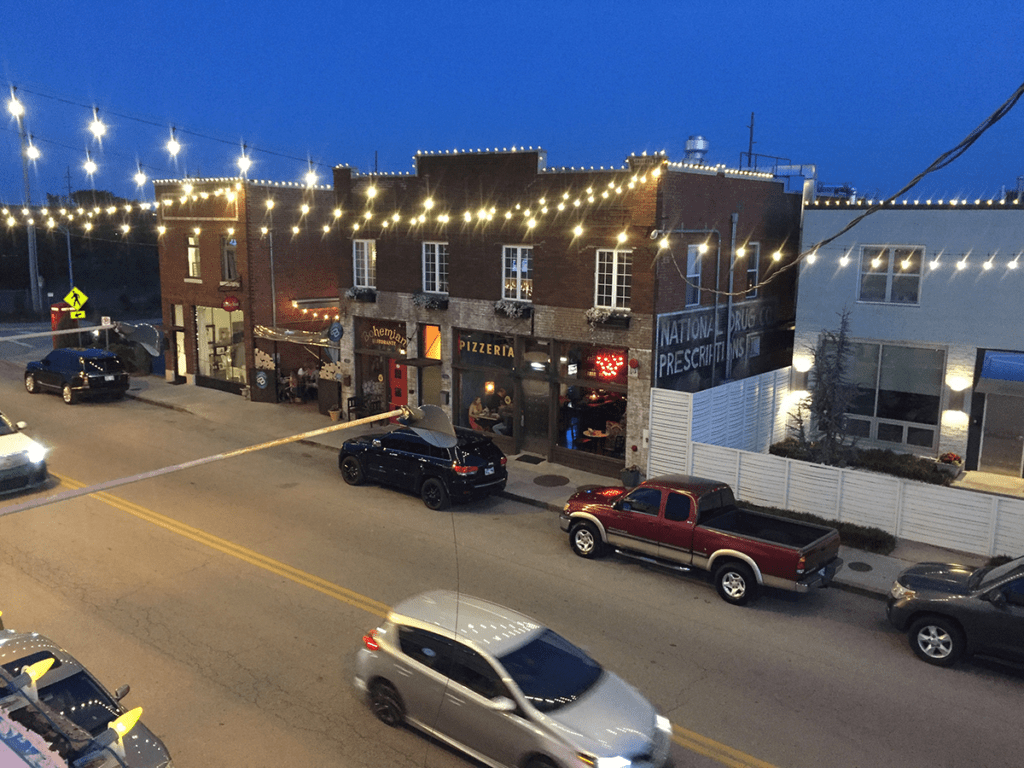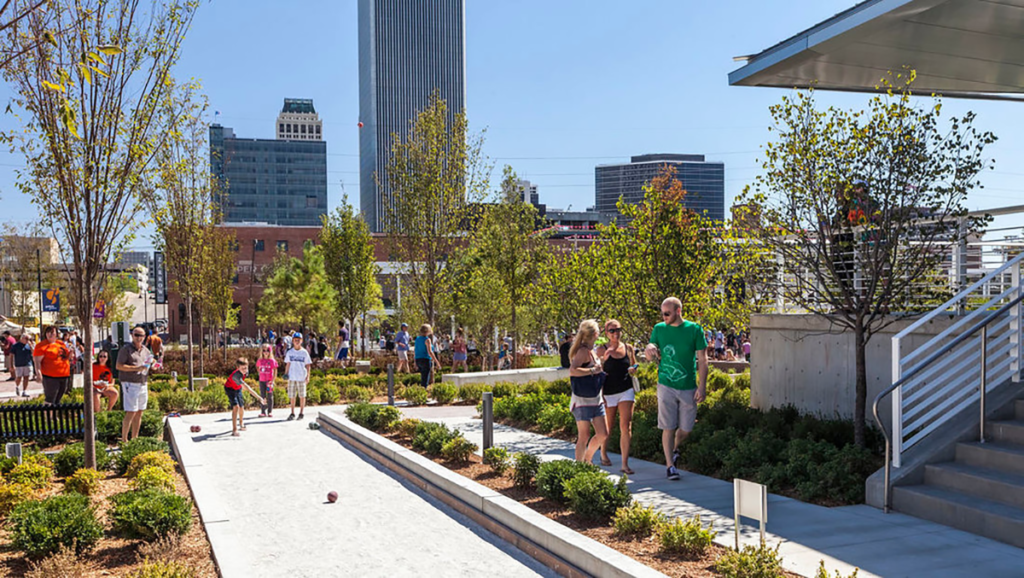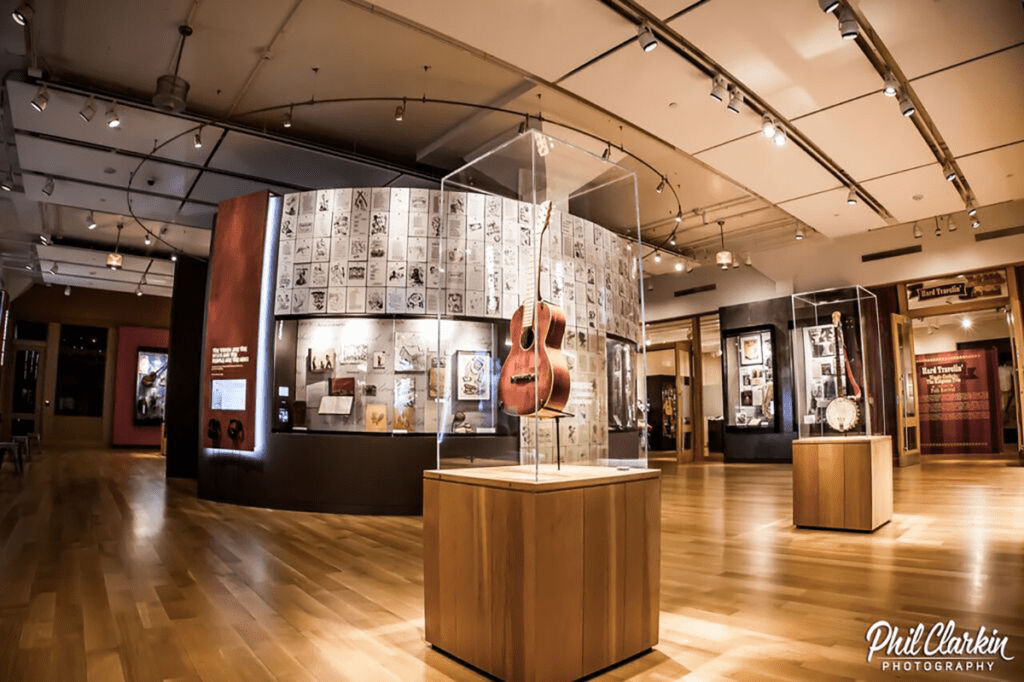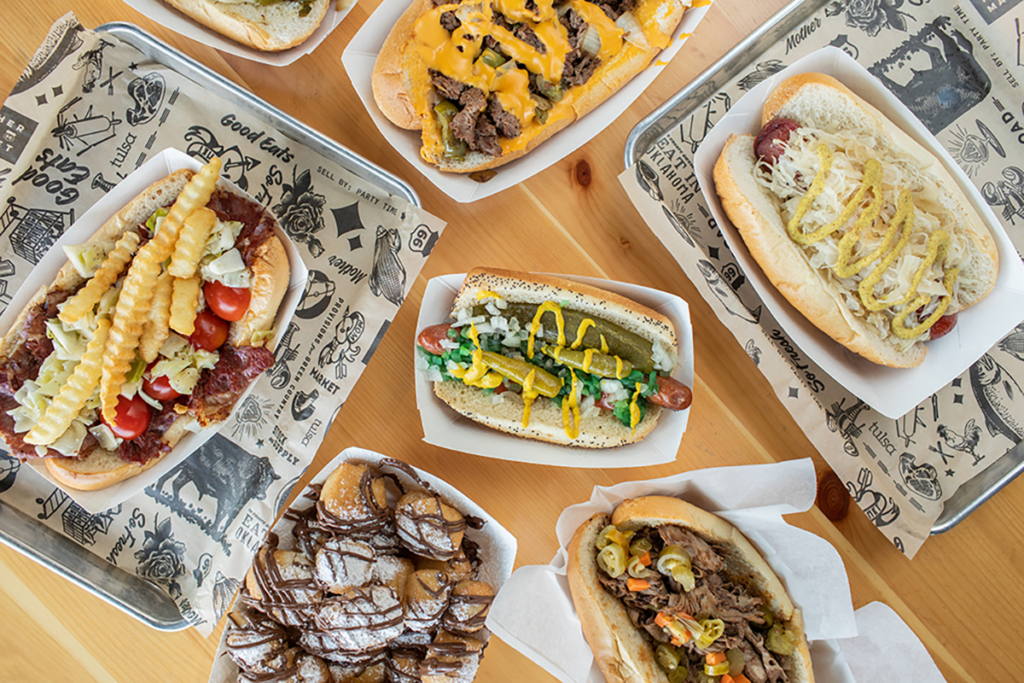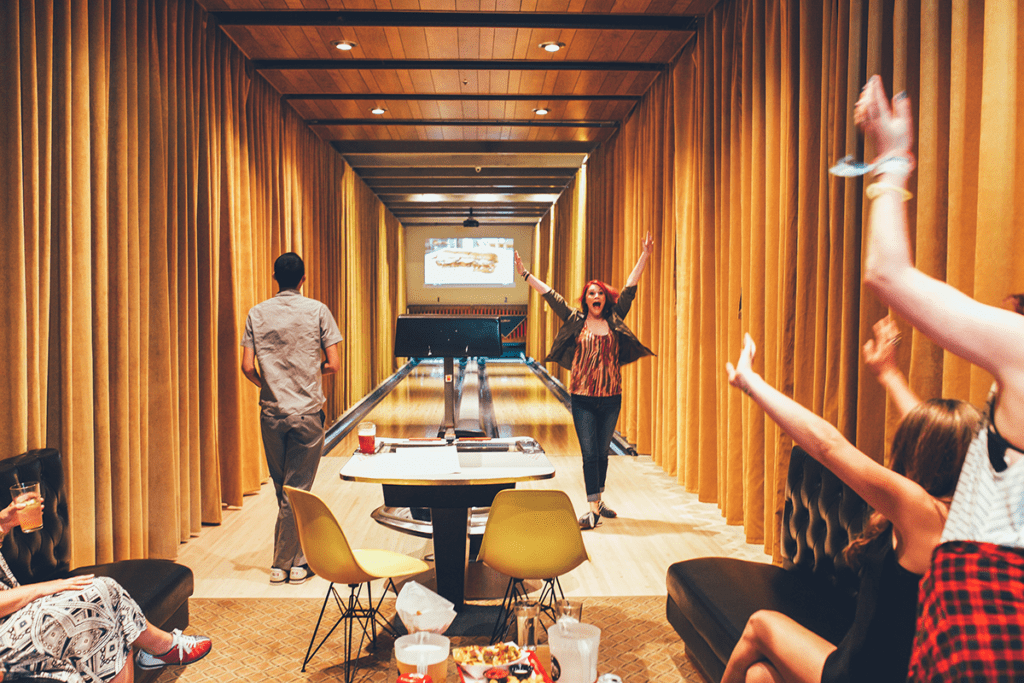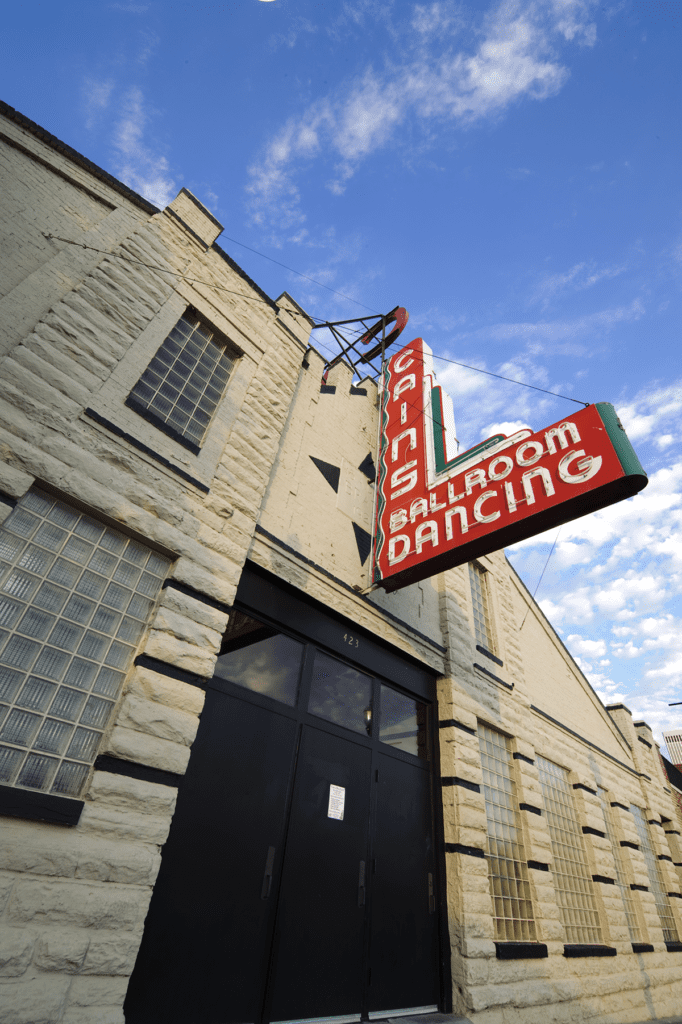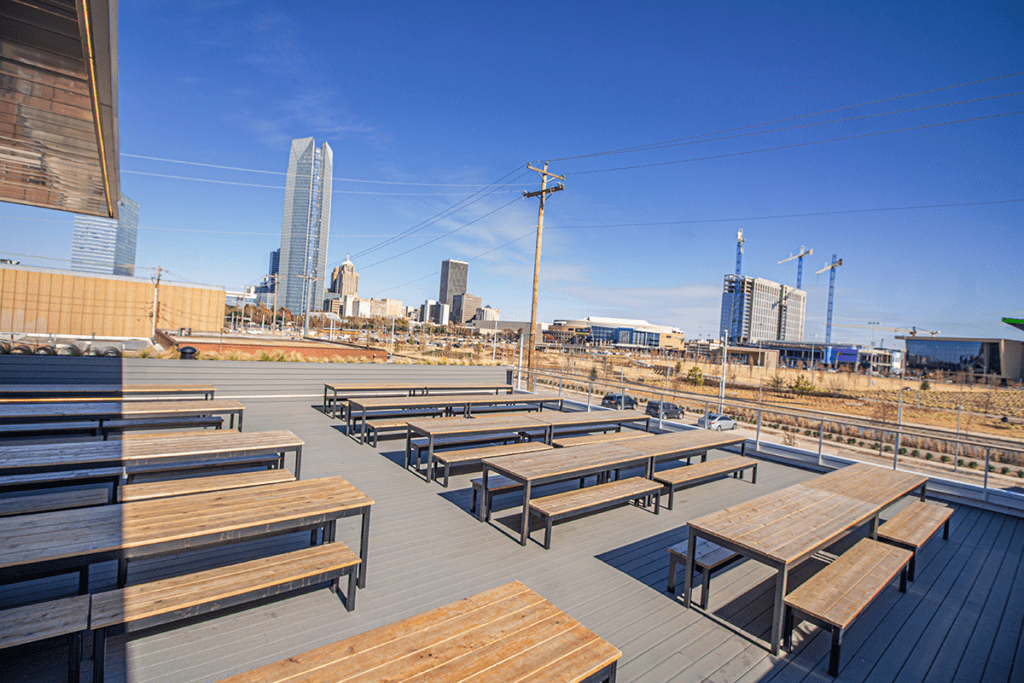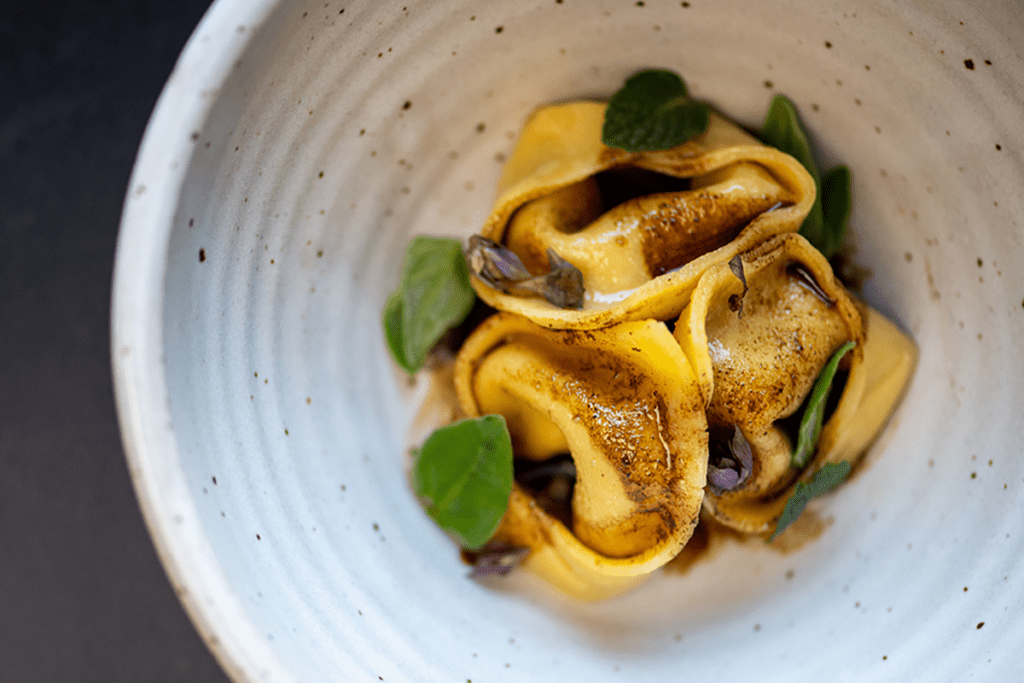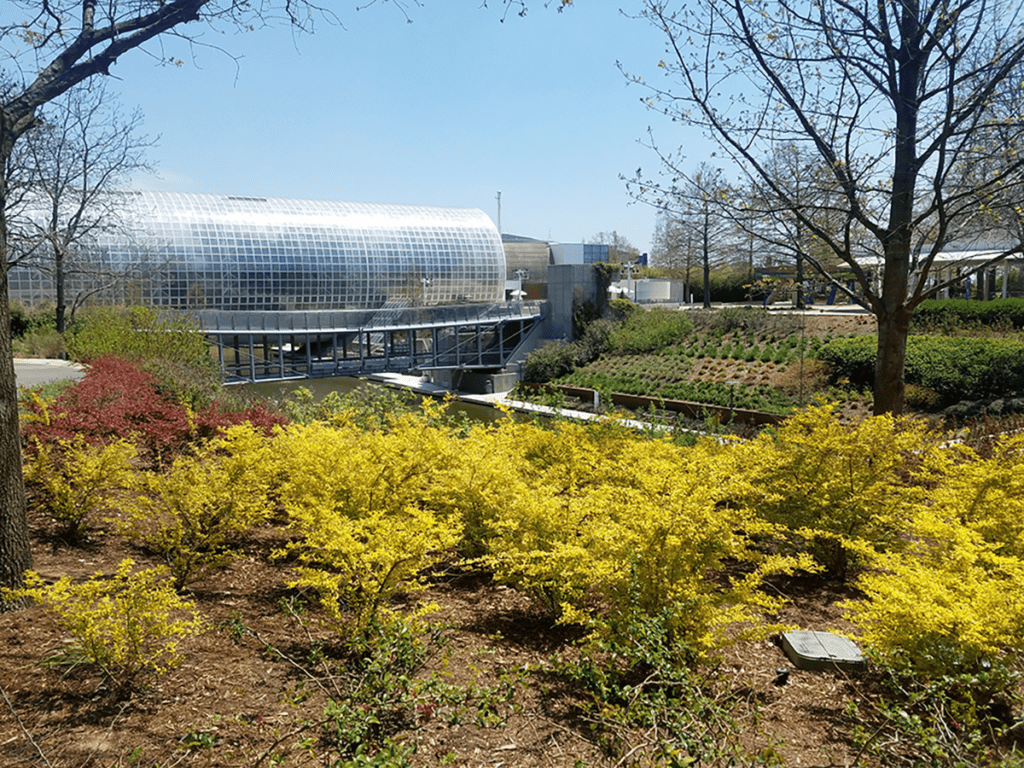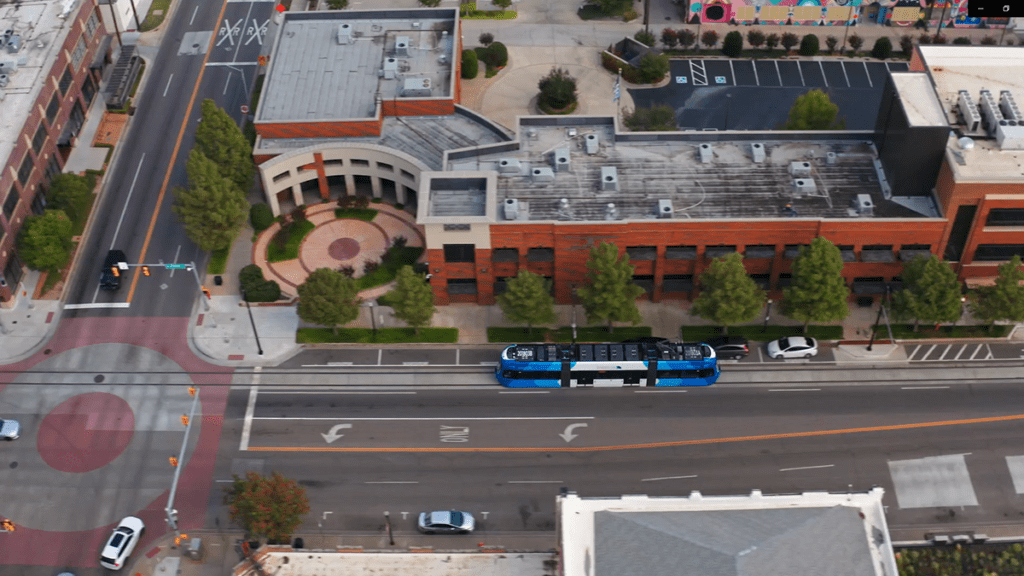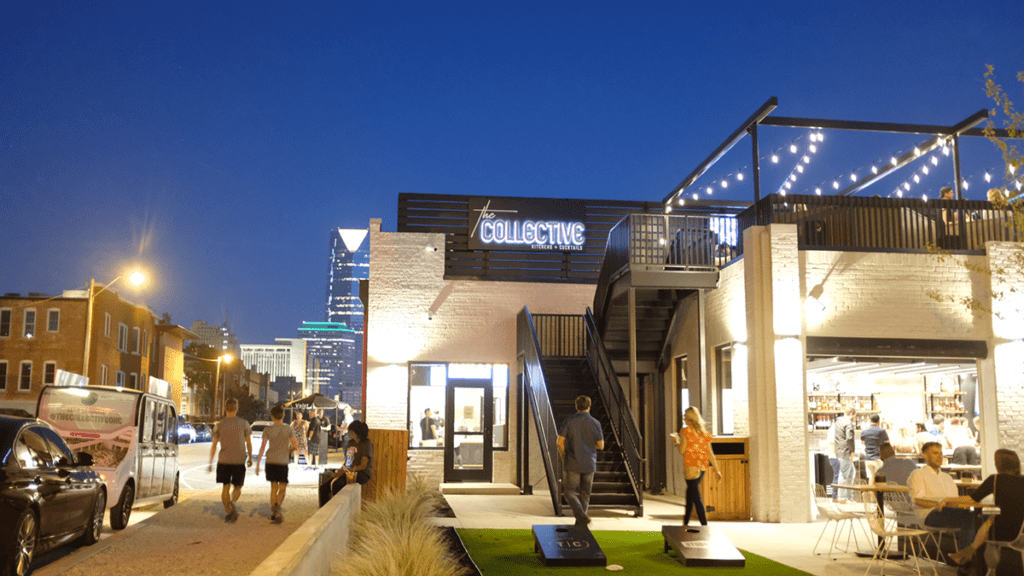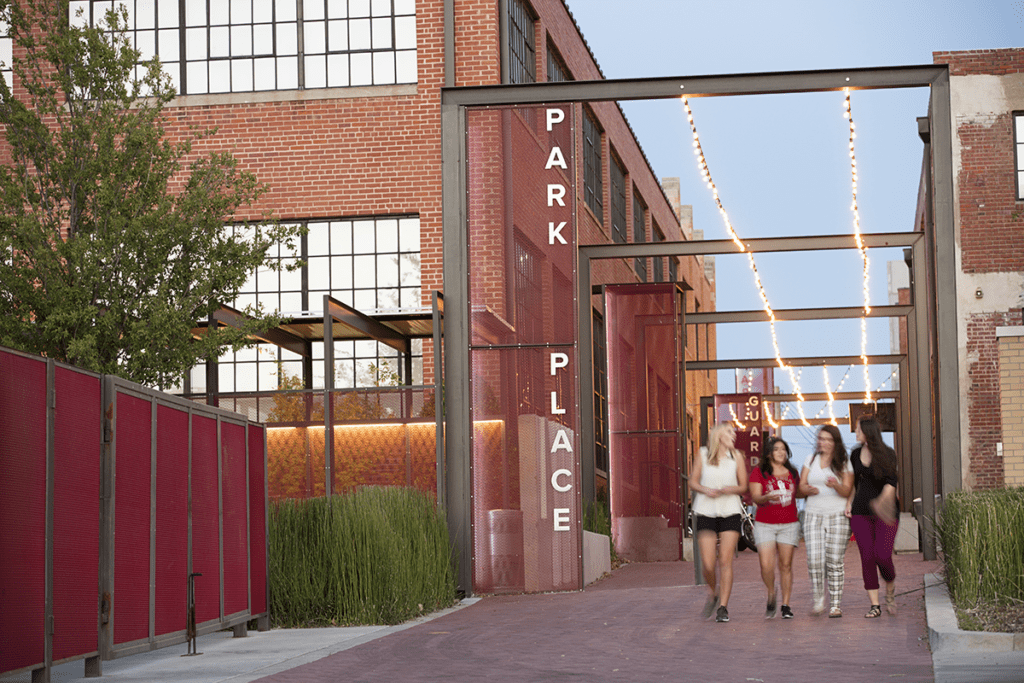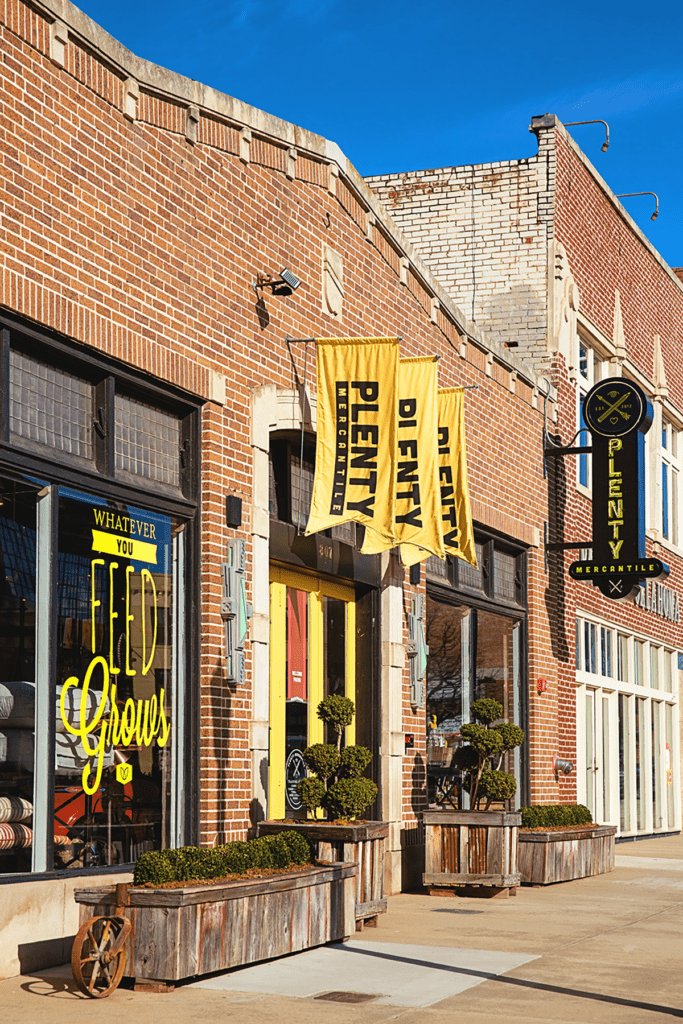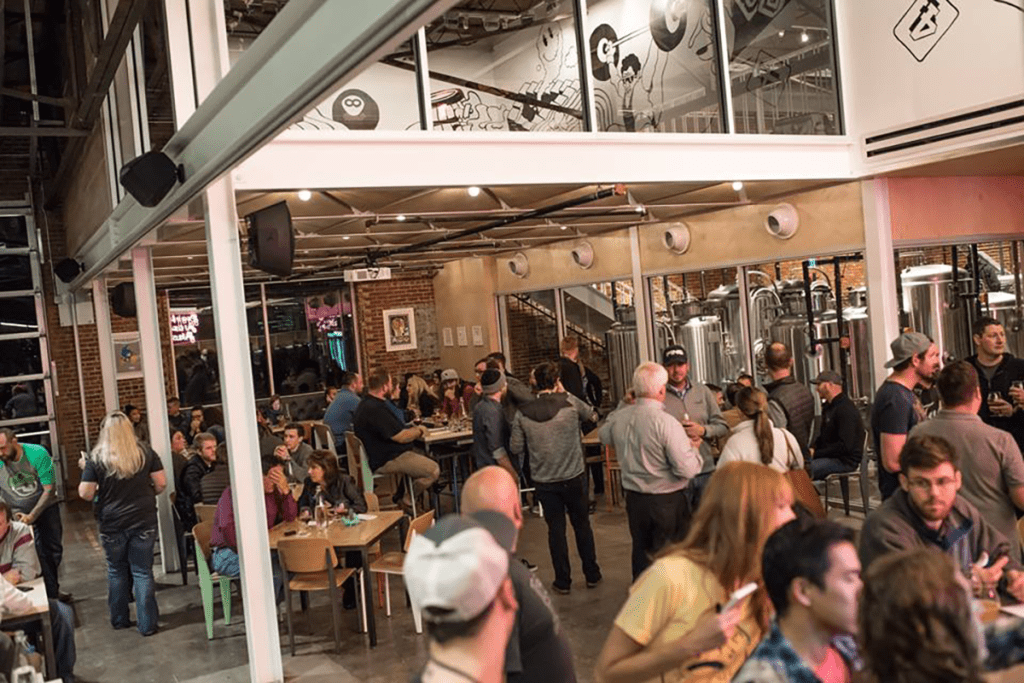
Cabin Boys Brewery 
East Village District 
Saturn Room Photo by Jessica Karin Photography 
Guthrie Green Photo by Jonnu Singleton 
Woody Guthrie Center 
Metropolis at Mother Road Market Photo courtesy Lobeck Taylor Family Foundation 
Dust Bowl Lanes and Lounge, Tulsa and OKC Photo courtesy McNellie’s Group 
Cain’s Ballroom 
American Solera, Tulsa
Tulsa
by Tracy LeGrand
Tulsa Arts
One of the oldest downtown hubs, the Tulsa Arts District is rich with iconic spots, like Cain’s Ballroom and the Tulsa Theater (formerly known as the Old Lady on Brady and the Tulsa Municipal Theater).
Culturally diverse and hopping, this district is where you can attend musical performances or just hang out on Guthrie Green, and participate in the monthly First Friday Art Crawl.
The Woody Guthrie Center, as a museum and event facility, memorializes one of Oklahoma’s most influential natives. In the same block on Reconciliation Way is the Henry Zarrow Center for Art and Education. The Arts District is also home, for the second year, to Tulsa International Mayfest, which has joined forces with Ahha. 108 Contemporary is another unique arts destination.
Dining and nightlife abound with Valkyrie or Welltown Brewing. Get a classic tiki cocktail at the Saturn Room. Eateries include Chimera, Amelia’s, Duet and Glacier Bean to Bar.
“Downtown in itself is a neighborhood of districts,” says Brian Kurtz, executive director of Downtown Tulsa Coordinating Council, referring to the Arts, Greenwood, Blue Dome, Art Deco and East Village areas. “You can find dining, retail and entertaining options within each district and still it’s all part of downtown.”
Greenwood
With a storied past as Black Wall Street, Greenwood has cultural touchstones providing both entertainment and historic context. Along with the Greenwood Cultural Center, John Hope Franklin Reconciliation Park provides eye-opening and educational experiences.
“The John Hope Franklin Center for Reconciliation offers programs that: challenge our civic courage to connect with and … understand others [with different] experiences and beliefs; stimulate dialogue on pressing social issues; promote justice and universal cultures of human rights of diverse communities; and bring people together [by using] history to take on challenges to democracy and human rights,” executive director Reuben Gant says.
For entertainment, the district features Living Arts, the She Theatre and Lounge, and ONEOK Field, home of Tulsa Drillers baseball and FC Tulsa soccer. Dining opportunities include Wanda J’s Next Generation, Lefty’s and Fat Guys.
Blue Dome
Before or after shows, the down-to-earth vibe of the Blue Dome District lures concert goers with dining and cocktails.
El Guapo’s and Roof Sixty-Six boast bird’s eye views while you sip or sup. You can get a pint at McNellie’s, knock down pins at Dust Bowl Lanes and Lounge or travel back in time at Max Retropub. Other choices include the elegance of Juniper or the broth-and-noodle allure of Jinya Ramen.
“Fifteen years ago, the Blue Dome District was one of the first downtown districts coming to life, and McNellie’s Group was among our first sponsors,” says Malcolm McCollam, executive director of the Saint Francis Tulsa Tough bicycle races. “Saint Francis Tulsa Tough will once again begin three days of races with the McNellie’s Group Blue Dome Criterium on June 12, and we’re just as excited as ever.”
Deco
Tulsa is among the most Art Deco-bedecked cities on earth and nowhere is that more evident than in the Deco District, which has the Mayo Hotel and the Tulsa Geoscience Center.
The Art Deco Museum has Tulsa-centric gifts and many forms of fun at Decopolis. Dining options include Billy’s on the Square, Lassalle’s, Elote and Ti Amo.
“The Deco District has continued to have significant development and investment with new hotels, retail, public arts and investments in the public realm, making it a desirable part of downtown,” Kurtz says. “There’s Tulsa Club Hotel and another hotel coming along with luxury housing [and] workforce housing. Excitement is building with lots happening.”
East Village
A quick glance at the East Village Facebook page shows an up-and-coming Tulsa presence called “the sunny side of downtown.”
Drink and dining options include: East Village Bohemian Pizzeria, with happy hours and lunch specials from brother-sister duo Pat Johnson and Amy McMillin; the Goat Bar and Kitchen; Lowood; Hodges Bend coffeehouse and cocktail bar; and Whiskey 918.
You can catch a play at American Theatre Company or satisfy your sweet tooth at Rose Rock Microcreamery while checking out who’s playing at the Boxyard.
Pearl District
The Pearl District’s history is filled with musical legend because it’s home to the Church Studio, Leon Russell’s church-turned-recording studio, where the famous Tulsa Sound was born in the 1970s. In recent years, the Pearl has experienced a renaissance with entertainment and cultural opportunities developing alongside longtime mainstays like Centennial Park and the Nightingale Theater.
The Mother Road Market is Tulsa’s first food hall, a community space with retail and food concepts. The Vault is a pop-up retail space for entrepreneurs. Classic eateries include El Rancho Grande and Ike’s Chili House. For Cajun grub and live blues, Swamp House delivers. Stand out bars include the Dead Armadillo, Blackbird on Pearl and Pearl Beach Brew Club.
Brookside
Once upon a time, Brookside was the car-cruising strip of choice for mid-20th century Tulsa. These days, it’s a hip, happening spot with boutique shopping, like the Ida Red general store and Richard Neel Home, along with fine dining at Doc’s and seafood and sushi at In the Raw. Check out Bricktown Brewery or Elmer’s for burgers and brews.
Brookside has some of the most popular bars in Tulsa: R Bar, Warehouse and Another Round. The district is also known for its farmers market, strolls in Woodward Park and celebrations of spring with Herb Day on Brookside.
Cherry Street
Cherry Street is Tulsa’s only shopping district in a recognized historic district with boutiques at Nest, Slade and Ascent and one of the largest new age bookstores in the country, Peace of Mind.
Enjoy a cup of joe at Coffee House on Cherry Street or find your Irish at Kilkenny’s. Brother’s Houligan, Society Burger and Main Street Tavern are also handy for a burger and brew.
Cherry Street, the original name for 15th Street, is partially closed on Saturday mornings throughout the spring and summer for one of the biggest farmers markets in the region.
Kendall-Whittier
Kendall-Whittier is a vibrant community with Circle Cinema, unique brew experiences at American Solera, food truck festivals and shopping. Fellowship among residents and visitors has flourished in recent years, says Lori Decter Wright, executive director of Kendall Whittier Inc., a nonprofit growing food for low-income people. “Those who don’t need our services are also welcome to engage in events or help garden,” she says. “Nourishment isn’t just food; it’s connecting with your neighbors.”

Social Capital 
Nonesuch Photo by Rachel Maucieri – Maucieri Visuals 
Myriad Botanical Gardens, OKC 
Oklahoma City streetcar Photo courtesy Downtown Oklahoma City Partnership 
Scissortail Park 
Plaza District Festival 
The Collective Photo courtesy Downtown Oklahoma City Partnership 
Midtown, OKC Photo by Shevaun Williams 
Plenty Mercantile, OKC Photo by Shevaun Williams 
Prairie Artisan Ales
OKC
by Kimberly Burk
City Center
Oklahoma City’s offerings of food, drink, entertainment and retail are increasingly grouped in districts, six of which are connected by the Oklahoma City streetcar.
“The streetcar has really transformed the way people move about,” says Danielle Dodson, communications manager for the Downtown Oklahoma City Partnership. “It allows them to go to a favorite spot in Midtown, then come back downtown for a concert. The small-business owners stuck it out through the construction process, and now they are really benefiting.”
City Center’s biggest draw is the Oklahoma City National Memorial and Museum, Dodson says. Sporting events and conventions also bring people downtown, as do music and theater offerings at the Civic Center.
Popular night-time dining spots include Vast, Kitchen 324 and The Manhattan.
Scissortail Park, which opened last year, also brings customers to downtown restaurants. Social Capital, a stop on the streetcar route, has more than 100 beers on tap and offers a view of the park from its rooftop patio.
Midtown
Midtown connects downtown with the historic neighborhoods to the north. Barrios Mexican Kitchen, The Hall’s Pizza Kitchen, Café Do Brazil and the Bleu Garten food truck park pack in the diners.
Dust Bowl Lanes and Lounge is a bowling alley with 12 lanes, a full bar and a fun menu with items such as Xtreme Tots, which come topped with bacon, chili, onions, cheese, jalapenos and ranch dressing.
Retail includes Mode and The Black Scintilla for trendy women’s wear, the stationery shop Chirps and Cheers, and Commonplace Books, which features poetry readings, lectures and children’s story time.
Automobile Alley
The stunning home of the Oklahoma Contemporary Arts Center is at Northwest 11th Street and Broadway Avenue on the northern boundary of Automobile Alley.
“Broadway is a huge corridor for retail,” Dodson says. “You can park and walk and go into 10 shops.”
For home décor, offerings include Plenty Mercantile, Tin Lizzie’s and Urbane. The Cargo Room, Hans Herman’s Tailors and the Oklahoma Shirt Company are among the clothiers.
Automobile Alley is also a place to wet one’s whistle; favorites include Prairie Artisan Ales, Sidebar Barley, the Wine Bar and Coffee Slingers. Eateries include Cultivar, Hatch, Iguana Mexican Grill and the Parlor, a food hall with seven restaurants and two bars.
Bricktown
Bricktown’s Criterion, a concert venue, has a partnership with a booking agent, Dodson says, “and they are getting some great new acts.”
The Bricktown water taxi is a perennial favorite, along with the American Banjo Museum, Bricktown Comedy Club, Jim Thorpe Museum and the Chickasaw Bricktown Ballpark, home of the OKC Dodgers. Brickopolis boasts laser tag, an arcade, miniature golf and a bungee trampoline.
Food and drink options include Toby Keith’s, Micky Mantle’s, Henry Hudson’s Pub and Tapwerks.
Plaza
The rebirth of this district “started off really small,” just over 20 years ago, says Selena Skorman, executive director of the Plaza District Association and Plaza Business Alliance.
“They were pulling weeds and picking up trash – ground-level grassroots stuff,” Skorman says of residents who formed a nonprofit to tackle blight and attract a variety of businesses. “In the 1980s, artists moved in and lived in the back of the stores and had shops out front. That made our district culturally rich and vibrant.”
Skorman says the district has something for everybody, including the Lyric Theater, boutiques and salons. The Pie Junkie, Empire Slice House, Saints Pub and The Mule are big draws, she says of Plaza eateries.
Live on the Plaza, a block party and art walk, is the second Friday of every month.
Paseo Arts
The Paseo Arts District, with its Spanish revival architecture, was developed in 1929 as the first shopping center north of downtown, says Amanda Bleakley, executive director of the Paseo Arts Association.
The Paseo “has a real welcoming feel, with the way the street is curved, and the buildings are painted different colors,” Bleakley says. “Quite often when you shop at the studios and galleries, the artist will be there.”
Restaurants include Picasso Café, Paseo Grill and Gun Izakaya, which Bleakley says is “Japanese street food with really good cocktails.”
For shopping, Bleakley’s favorites include Eden Boutique and Betsy King: A Shoe Boutique. ReModernOk has mid-century modern furniture and accessories.
Crowds gather for the Paseo Arts Festival on Labor Day weekend and the monthly First Friday Gallery Walk.
Uptown 23rd
The Tower Theatre is a concert venue and movie house that was brought back to life recently in the Uptown 23rd district.
Food stars include The Drake and Cheevers. Craig’s Curious Emporium offers unconventional gifts. Wet your whistle at Pump Bar, Ponyboy or the Bunker Club.
Western
Perhaps the city’s most eclectic district within a district is Western Avenue, home to everything from the high-end shops on Classen Curve to antiques stores and Guestroom Records, a haven for vinyl lovers.
Flip’s Wine Bar and Stella Nova anchor the drinking scene, and restaurants include Osteria, Iron Star Urban Barbecue, The Drum Room and Sushi Neko.
Stockyard City
Lest anyone forget Oklahoma City’s origins, Stockyard City is just southwest of downtown and the place to find cowboy hats and boots, a juicy steak, live country and western music, Native American jewelry and Mexican baked goods. Places to hang your hat include the Rodeo Opry, the OKC Rattlesnake Museum and Rodeo Cinema.
And yes, people still buy and sell cattle every week at the Oklahoma National Stockyards.






















